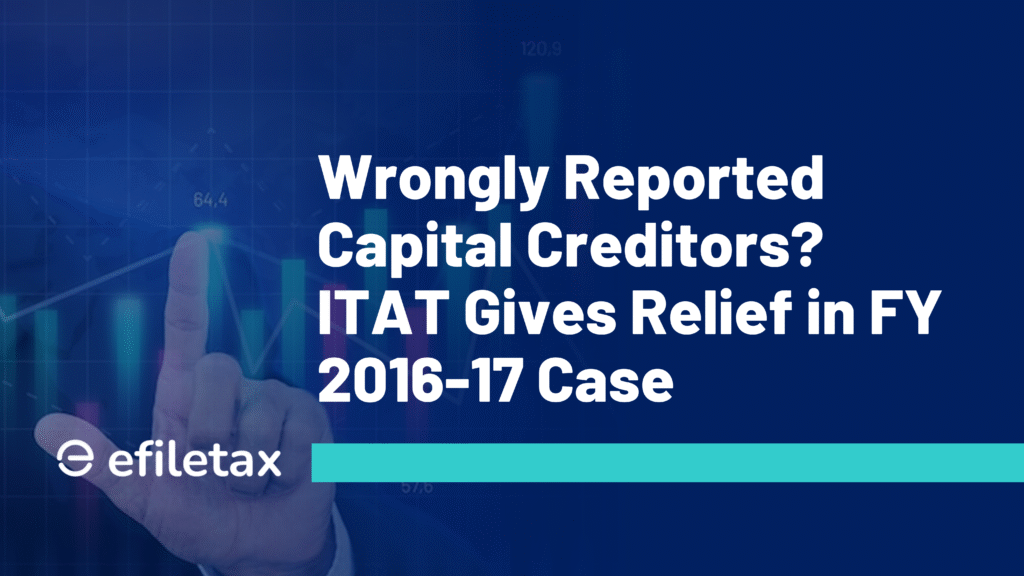
Capital Creditors vs. Trade Payables: ITAT Clarifies Tax Treatment
Focus Keyphrase: capital creditors trade payables
In a recent case, the Income Tax Appellate Tribunal (ITAT) provided clarity on the difference between capital creditors and trade payables, especially when past-year creditors are mistakenly shown under the wrong head in future financials. This ruling is key for businesses and professionals dealing with accounting accuracy and scrutiny during assessments.
Case Summary: What Was the Issue?
- The assessee, a company, had capital creditors in FY 2015–16.
- In FY 2016–17, due to a clerical error, these were mistakenly shown as trade payables.
- During assessment, the Assessing Officer (AO) treated this as unexplained credit under Section 68 of the Income Tax Act, 1961.
- AO added it to the taxable income, alleging lack of explanation or supporting documents.
- The assessee clarified that these were opening balances from earlier years and not new transactions.
ITAT’s Observations and Ruling
The Chennai Bench of the ITAT ruled in favour of the assessee. Here’s why:
- No fresh credit appeared in FY 2016–17. The amounts merely continued from the previous year.
- The ledger showed these were old balances related to capital goods purchases.
- Just because they were misclassified in the books, no income can be deemed to arise under Section 68.
- ITAT quoted Delhi High Court in CIT v. Vardaan Fashion (2014), which held that mere book entries do not trigger Section 68 unless there’s actual unexplained cash or credit.
Verdict:
👉 The ITAT upheld the CIT(A)’s decision to delete the addition.
Why This Matters to Indian Businesses
Key Takeaways:
- Capital creditors trade payables must be accurately classified to avoid scrutiny.
- A misclassification, even if unintentional, can invite unnecessary litigation or income addition.
- Maintaining clean audit trails and proper documentation is essential.
Section 68: What You Need to Know
Section 68 deals with unexplained cash credits. If any sum is found credited in the books of the assessee and no satisfactory explanation is provided, it can be treated as income.
However, this case shows that:
✅ Old balances don’t attract Section 68 if their origin is explained.
✅ Change in classification (capital to trade) is not sufficient for tax addition.
✅ Supporting invoices, ledgers, and payment trails are key for defending such entries.
Expert Insight:
“While Section 68 is powerful, its application must be grounded in real evidence. Clerical errors in classification should not be equated with tax evasion. Businesses should reconcile creditor accounts yearly and disclose legacy balances clearly.”
— CA Vikram Mehta, Tax Consultant
Reporting Tips to Avoid Future Issues
Here’s a checklist for preventing capital-trade misclassification:
- ✅ Reconcile opening balances in capital accounts every FY
- ✅ Maintain supplier-wise ledgers
- ✅ Tag creditors under correct heads in ERP/software
- ✅ Review old entries during audit preparation
- ✅ File tax audit reports with proper schedules and disclosures
Similar Case You Can Read
- CIT v. Vardaan Fashion (2014) 43 taxmann.com 544 (Del.)
Read Judgment on indiankanoon.org
Summary
The ITAT ruled that capital creditors from FY 2015–16 wrongly shown as trade payables in FY 2016–17 cannot be taxed under Section 68. No fresh credit or unexplained income existed. Classification errors don’t justify additions if origin is proven.
Frequently Asked Questions (FAQ)
1. Can capital creditors be treated as income if misclassified?
No. As per ITAT, unless there is fresh unexplained credit, mere reclassification doesn’t attract Section 68.
2. What’s the difference between a capital creditor and a trade payable?
- Capital creditor: Supplier of capital goods or fixed assets.
- Trade payable: Ongoing operational supplier (inventory, services).
3. Is proper classification important in the ITR and tax audit?
Yes. Wrong heads can result in wrong tax treatment, scrutiny, or even penalties.
Final Words
Misclassification of capital creditors as trade payables can be costly — but with proper records, explanations, and legal backing, taxpayers can avoid unjustified additions.